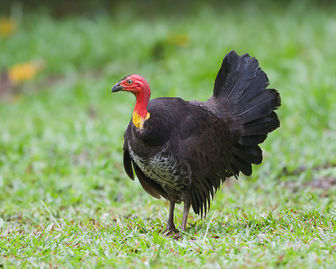Australian Brush-turkey
It is a spectacular large bird with a total length of 60–75 cm and a wingspan of about 85 cm. The subspecies A. l. purpureicollis from the northern Cape York Peninsula is smaller than the more widespread nominate subspecies. It has a prominent, fan-like tail flattened sideways, and its plumage is mainly blackish, but with a bare red head, and a yellow or purple wattle . The male's wattle becomes much larger during breeding season, often swinging from side to side as they run. The males' heads and wattles also become much brighter during the breeding and nesting season. The underside of the body is sprinkled with white feathers, more pronounced in older birds. The Brush-turkey flies very clumsily with heavy flapping when it is frightened and roosts in trees at night and during the heat of the day.

Original source: Own work
Author: JJ Harrison (http://www.noodlesnacks.com/)Camera location
The Australian Brush-turkey is classified as Least Concern. Does not qualify for a more at risk category. Widespread and abundant taxa are included in this category.
Australian Brush-turkey chicks hatch fully feathered and can fly within a few hours. More
* Australian Brush-turkey videos, photos & sounds on the Internet Bird Collection Retrieved from "http://en.wikipedia. More
the Australian Brush-turkey is the only species of bird in which sex ratio is confirmed to be incubation-temperature dependent, it is speculated that this is common to all Megapodes, as they share nesting methods unique among birds. The non-social nature of their incubation raises questions as to how the hatchlings come to recognise other members of their species, which is due to imprinting in other members of the order Galliformes. More
The Australian Brush-turkey is one of three megapodes in Australia. * The family name refers to the robust feet of all species. * It is a large, black turkey-like bird. The head is red head and the neck yellow, and these regions are featherless, giving it a vulture-like appearance. More
to the Australian brush-turkey and the chapter - the name of the chapter - is 'Turkish delight'. I actually love the bird because they're one of those species that aren't afraid of human beings because once they reach adulthood, once the brush-turkey has survived that chance of 1-in-200 survival in the first three or four months, once it gets there, it doesn't have any enemies. Well, any real enemies. But those that it does have, it knows it can escape easily. More
Australian Brush-turkey chicks hatch fully feathered and can fly within a few hours. Identification The Australian Brush-turkey has a mainly black body plumage, bare red head, yellow throat wattle (pale blue in northern birds) and laterally flattened tail. The Australian Brush-turkey is not easily confused with any other Australian bird. It is the largest of Australia's three megapodes (Family Megapodiidae). More
The Australian Brush-turkey is found in eastern Australia from Far North Queensland to Illawarra in New South Wales. It has also been introduced to Kangaroo Island in South Australia. It is the largest extant representative of the family Megapodiidae and is one of three species to inhabit Australia. Despite its name, the bird is not closely related to American turkeys. More
Australian Brush-Turkey Size: 60-65cm Habitat: Found in Australia from Cape York Peninsula south to Sydney and west to the Great Dividing Range. It favours dry scrub, rainforest and dense vegetation. Ground feeds on fruits seeds and insects. Notes: Head has featherless red skin with yellow at base of neck. Body black-dark brown, underbody pale grey bars. Breeds spring-summer builds large incubating mound. For more information on Australian Brush-Turkey see references. More
Australian brush-turkey is a common resident of many rainforest national parks and an occasional visitor to suburban gardens. The brush-turkey is one of three Australian species of mound-building birds, or megapodes. The other two species are the mallee fowl and the orange-footed scrubfowl. All are descendants of birds once found in the ancient land mass of Gondwana. Their closest relatives now live only in Papua New Guinea and South America. More
The Australian Brush-Turkey can be found from the Cape York Peninsula at the tip of Queensland to central NSW. It is most common in coastal districts but also extends to adjacent highlands and into the dense scrub west of the Great Dividing Range. The brush-turkey is normally an independent bird, but pairs and small social groups do occur. It is a wary bird, shying from noise and quickly darting for cover, however those that live near picnic areas tend to become quite tame. More
The Australian Brush-turkey is a large bird, 60-75cm in length and with a wingspan of 85cm. Males and females are a similar size and are blue-black in colour. The Brush-turkey has an upright fanlike tail and grey-edged breast feathers. It has strong legs and a naked deep red head and neck. The male has a large, bright yellow wattle while the female's is smaller and paler. Brush turkey chicks look much like quails, with plain rich brown feathers. More

Original source: maggie p au
Author: maggie p au
Permission: Some rights reserved
